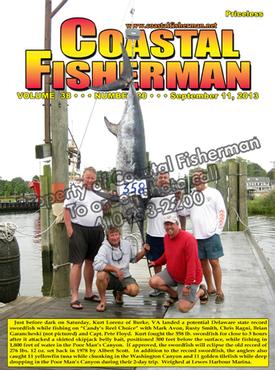


Article by Capt. Steve Katz
 End of Season
End of Season
Technically it is still summer and it is hard to believe this is the last “Ship Shape” column for this season. Don’t put away the boat yet, there is still a lot of good fishing this season.
While many boats head south for the fall and winter fishing season, many stay in this area for fishing or winter storage. We will review some maintenance tips for the off-season.
Batteries
Whether your boat is in the water or on land, maintaining your DC power system is a priority. If you keep your batteries on your boat during the winter, be sure they are fully charged at all times. A fully charged battery will not freeze (unless it is colder than -92° F). A battery at 40% charge can freeze at +16° F. If the electrolyte freezes, the battery is ruined due to internal plate damage. It is easiest to keep the battery charged by disconnecting the battery from the shipboard systems to eliminate any electrical loads and to use the on-board charger or a proper trickle charger for your battery. If you decide to disconnect the battery from shipboard systems, be sure there is a way for water to get out of the boat while in storage. If you are on land, a trailer or on a boat lift, you can remove the drain plug to allow for any water to drain from the bilge. With a larger boat, there may not be a drain, therefore you will need to be sure you have some type of pump to remove any water that gets into the bilge.
If you choose to remove the batteries from your boat for the winter, be sure to store them in a safe place. A charging battery can emit hydrogen gas while charging, so batteries need to be in a well ventilated environment. When storing batteries, be sure to cover the terminals so that nothing falls on the battery creating a short across the terminals. Go ahead, it is okay to store batteries on a concrete floor. A long time ago, battery cases were made with rubber and could create a conductive path from the battery to damp concrete, draining the battery.
Ventilation
Covering the boat with shrink wrap, tarps or canvas is a great idea to prolong the finish of the boat and protect it from leaves, snow, wildlife and other elements. While each of these systems protects the boat, we also need to be sure these system let the boat breathe. A covered boat will easily trap moisture during the normal heating and cooling cycles. Proper ventilation is necessary to allow this moisture to evaporate from the confines of the cover. If you plan to work on the boat during the off-season, you can fabricate the cover to allow easy access with plenty of clearance to move around while working under the cover.
Winterizing
Winterizing means a lot of different things to different people and different boats. The most basic is the outboard engine boat. The primary goal here is to be sure all water is drained from the engine cooling system, while at the same time performing some maintenance to prepare the engine for storage. Most engine owners manuals have detailed instructions for long-term storage. Nowadays, the fuel system is the most troublesome. The best case is to not have any gasoline fuel sitting in the tanks or engine during storage. There are many products you can add to your fuel tank to preserve the fuel and help prevent fuel problems within the engine. In the Ocean City area, we have non-ethanol gasoline available for boats, and this should be used for storage if you are not already using it year round.
Big boat or small, most winterizing for gas, diesel, inboard and outboard engines, focuses efforts on the removal of water by draining, blowing out with air or replacing with an antifreeze mixture. There are many other maintenance items that should be completed before an extended storage, such as engine oil change, gear oil change, filter change, fuel system maintenance, grease, impeller inspection/replacement, cooling system clean-out, adjustments such as belts and valves, inspections of mounts, brackets, bolts, exhaust systems and other areas that are often neglected during the prime summer season.
Boat’s with other systems need preparation for the winter too, such as generators, air condition, fresh water, toilet, bait wells, ice makers, misters, macerator pumps and more. Most of these systems are winterized by replacing the water within these systems with nontoxic antifreeze. Don’t forget to have your hooding tank pumped out while the marinas are open.
Review your list of boat projects for the off season, not just those new items you are planning to buy, but those things you thought of when you were out in the boat. The cracked gel coat, sticking hinge, broken snaps, stuck drawer, loose fitting and more. Many of these items do not take much effort to fix in the off season and will make the boat even more enjoyable when you get it ready for next season. If your boat is stored out of the water, place your priority to the items below the water line, both in the bilge and outside the boat.
Performing the above tasks, along with a good cleaning and waxing, will put you ahead of the curve when spring arrives.
Captain Steve Katz, ABYC Master Technician, is owner of Steve’s Marine Service serving Annapolis and Ocean City, MD.